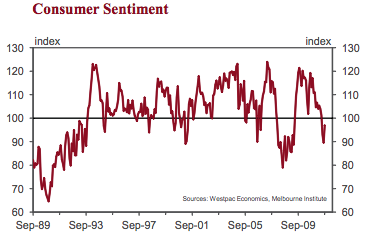
Consumer Confidence for September is out and shows a jump of 8.1%.
Bill Evans puts this down to:
This is a surprisingly strong result. We think it emphasises just how important interest rates are to households. Recall that since early May the Reserve Bank has been threatening to raise interest rates. As recently as the August Board meeting it was widely reported that the Board discussed a further rate increase. However, as a result of the escalating turmoil in the global economy and evidence of a slowdown in the domestic economy the Bank is no longer threatening to raise interest rates. Concrete evidence of the improved outlook for interest rates came shortly after the August survey when the major banks actually lowered their fixed rate mortgage rates. While possibly coming as a surprise this action would have comforted anxious households.
I see nothing to gainsay this analysis. And Evans has more proof:
There was further evidence that prospects for steady interest rates have boosted confidence. The index tracking responses on “whether now is a good time to buy a dwelling” jumped by 15.1%. It is now at its highest level for two years and is certainly sending an encouraging signal to an otherwise subdued housing market. There is a risk that this signal may be overstating the prospects for the housing market. With households still being particularly concerned about their own financial position over the next 12 months there is a risk that, while seeing value, they will not be prepared to act on this.
There is some support for our cautious view on housing in households’ attitudes towards the wisest place for savings. This question did not send quite the same positive message to the housing market with a modest increase (14.6% to 16.8%) in the proportion of respondents who favoured real estate as a wise place for savings. That was despite a further reduction in those favouring equities from 8.4% to 7%. In both cases household favourability continues to run at historically low levels.There was also a big shift away from favouring paying down debt (down from 23.9% to 18.7%) towards bank deposits (up from32% to 37.8%). That is the highest proportion supporting bank deposits since December 1975.
So, how do we read these results? There has been a steady bottoming in most credit aggregates in the past few months and the bounce in housing and general sentiment confirms it as a bottom for now.
But, let’s not forget the reason rates have stopped rising. Mostly, according to the RBA, it’s global economic weakness. That is the swing factor. If it get’s worse, as is my base case, then this will be a temporary reprieve in sentiment as job security surges as a worry. If it doesn’t deteriorate further, the bounce makes it unlikely we’ll see rate cuts, but we’ll probably still see some unleashing of pent up demand in housing and consumption, until more rate rises.
It seems Australians very much prefer a touch of global chaos to adjusting to the mining boom, thanks very much. Full report below:

